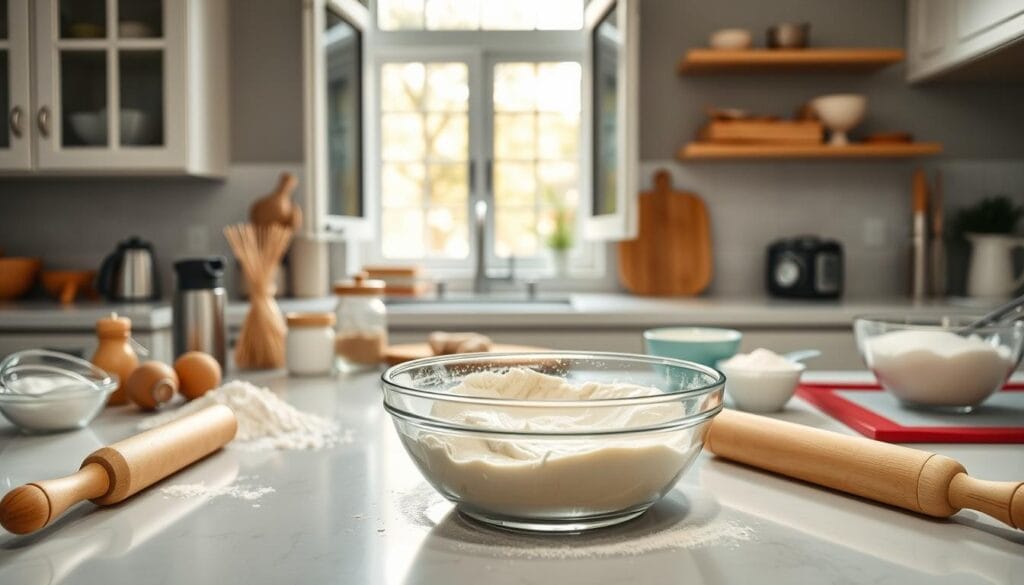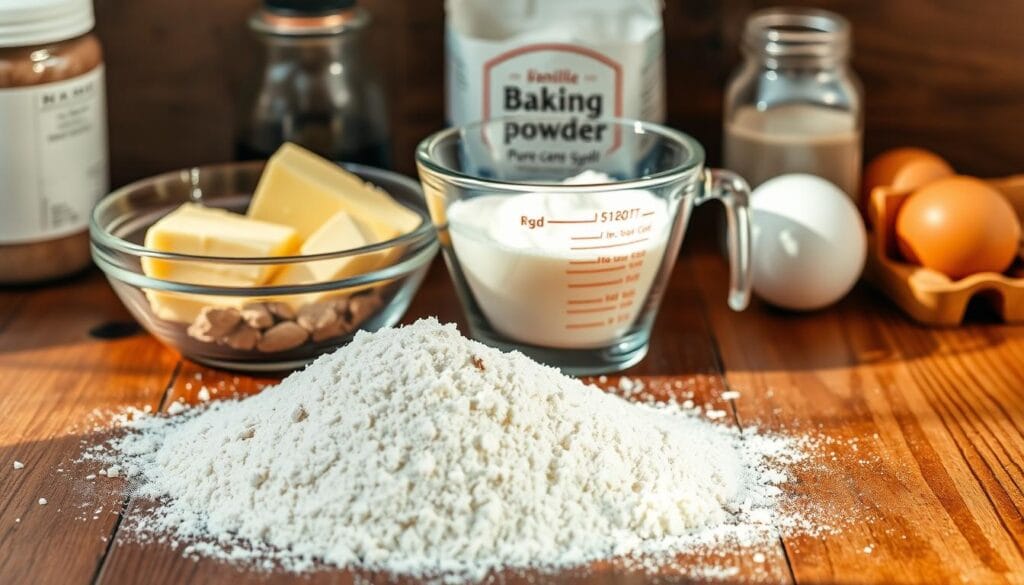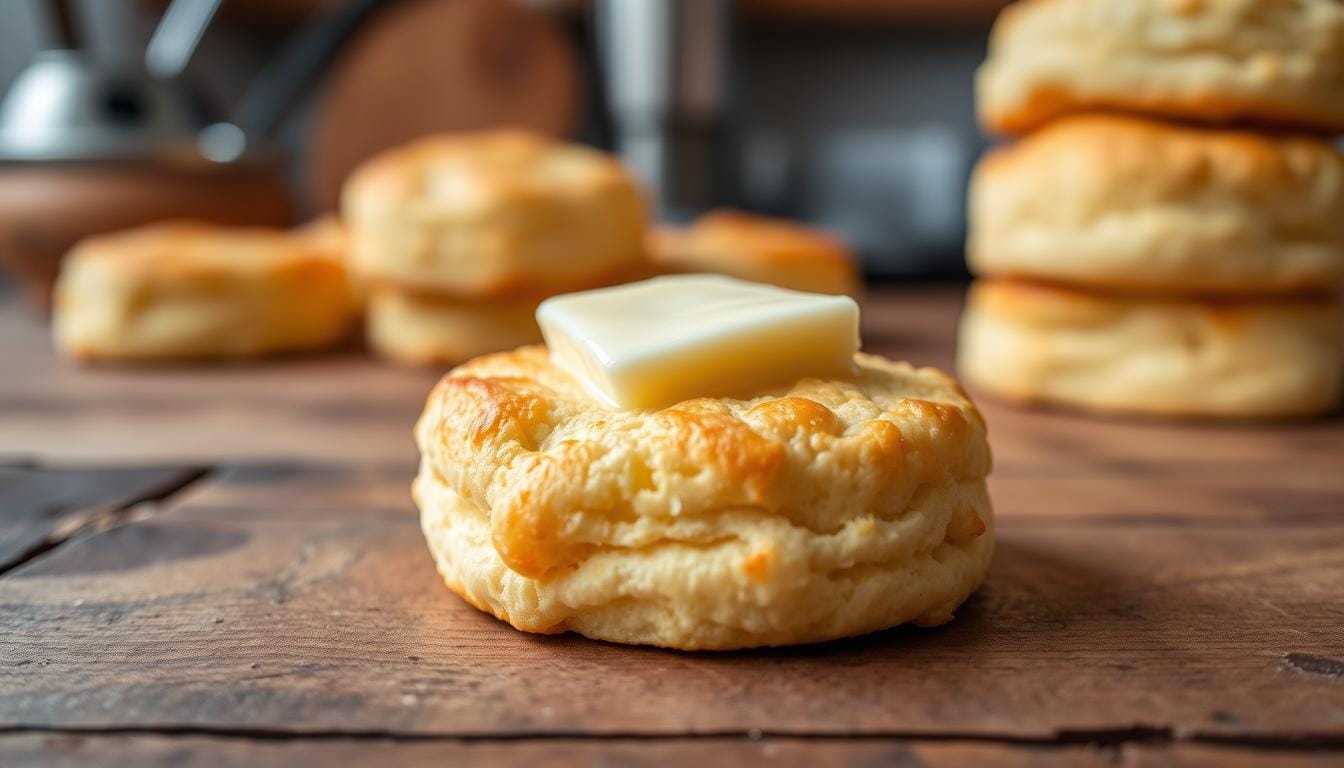What makes a perfect Gluten Free Biscuit Recipe? Is it the flaky texture, the buttery flavor, or the ease of preparation? You’ll find it’s all these things. With the right ingredients and techniques, you can make Flaky Biscuits that are delicious and tender. They’re perfect for any occasion.
Buttery Biscuits are a favorite in many American homes. With this recipe, you can make them at home too.
Exploring Gluten Free Biscuit Recipe teaches you about using the right flour blend. You’ll learn how to handle the dough for the perfect texture. Cold ingredients are key to making Flaky and Buttery Biscuits.
This recipe makes 6 gluten-free biscuits, each with about 400 calories. So, what are you waiting for? Start making Flaky, Buttery Biscuits at home today.
Table of Contents
Understanding Gluten-Free Baking
Gluten-Free Baking is a special and tricky process. It needs you to know how Gluten-Free Flours work. Gluten is a protein in wheat, barley, and rye that makes dough stretchy and strong. In Gluten-Free Baking, we use other flours to get this stretchy feel.
When making Gluten-Free Recipes, the flour you choose is key. You might use almond flour, coconut flour, or rice flour. Each flour is different and needs special handling. By trying out different flours and methods, you can make gluten-free treats that are just as good as the real thing.
For great Gluten-Free Baking, mix different flours together. Add xanthan gum to help with texture. And don’t overmix the dough. With a bit of practice, you’ll get the hang of Gluten-Free Baking and enjoy making all sorts of tasty gluten-free dishes.

- Almond flour: ideal for cakes, cookies, and pastries
- Coconut flour: often used in combination with other flours, adds fiber and protein
- Rice flour: light and delicate, suitable for baked goods like cakes and muffins
Learning the basics of Gluten-Free Baking and trying out different flours and methods will open up a world of tasty gluten-free recipes. You’ll be ready for any occasion with your gluten-free creations.
Essential Ingredients for Gluten Free Biscuits
Making gluten-free biscuits requires the right ingredients. You’ll need gluten-free flours, cold butter, and buttermilk for a tender texture. The choice of Gluten-Free Biscuit Ingredients greatly affects the taste.
You’ll also need Baking Powder and Baking Soda for the biscuits to rise. Use 1 teaspoon of baking powder for every cup of flour. Cold butter is key for flaky layers.

Key Ingredients to Use
- Gluten-free flours, such as store-bought gluten-free all-purpose flour blends
- Cold butter, essential for achieving flaky layers
- Buttermilk, which helps to create a tender and flaky texture
- Baking Powder, which helps the biscuits rise
- Baking Soda, which helps to balance the acidity in the buttermilk
Alternative Baking Powders and Baking Sodas
Looking for alternatives? You can use baking soda and cream of tartar to make homemade baking powder. Try different gluten-free flours to find your favorite.
Preparing Your Kitchen for Baking
To start baking, you need to prepare your kitchen with the right Baking Tools and keep it clean. This is key for making tasty gluten-free biscuits. The right tools and a clean space make baking easier and more fun.
A kitchen stocked with Baking Essentials like a pastry blender, rolling pin, and baking sheet is vital. Also, having a clean and organized workspace is important. It helps prevent mess and ensures your biscuits are light and flaky.
- Invest in quality Baking Tools to make baking easier and more efficient.
- Keep your kitchen clean and organized by washing utensils and equipment after each use. Store them in a designated area.
- Make sure you have all the necessary Baking Essentials before starting to bake. This includes ingredients, tools, and equipment.
By following these tips, you can make your kitchen perfect for baking gluten-free biscuits. Always use quality Baking Tools and keep your kitchen clean for the best results.
The Best Gluten-Free Flour Combinations
Finding the right flour mix is key for gluten-free baking. You can pick from Homemade Flour Mixes or Store-Bought Flour Blends. Homemade mixes let you tailor the blend, while store-bought options are convenient and consistent.
Popular mixes include rice flour, almond flour, and coconut flour. You can mix these in different ratios to make your own blends. Store-Bought options like Bob’s Red Mill 1:1 Gluten-Free Baking Flour make things easier and more consistent.
Think about the recipe and what you want your baked goods to be like. Rice flour is good for light treats, while almond flour works well for denser ones. Trying out different mixes can help you find the perfect one for your gluten-free baking.
It’s also important to measure and mix your flours correctly. The right mix and a good recipe can make gluten-free baked goods just as tasty as the traditional kind.
Step-by-Step Guide to Making Gluten Free Biscuits
To make delicious gluten-free biscuits, follow this simple guide. Start by preparing your ingredients. You’ll need 2 cups of gluten-free flour blend, 1 teaspoon of xanthan gum, and 1/4 cup of cold unsalted butter. In a large bowl, mix the dry ingredients together. This includes the gluten-free flour blend, xanthan gum, and salt.
Next, add the wet ingredients. You’ll need 6 tablespoons of cultured buttermilk and 1 large egg. Mix these ingredients until a dough forms. Then, fold the dough onto a floured surface and knead it gently. This will make it smooth and pliable.
Some key tips to keep in mind when making gluten-free biscuits include:
* Use a mix of gluten-free flours for the best texture and flavor.
* Add xanthan gum to get the right texture.
* Use cold ingredients to help the biscuits rise.
* Don’t overmix the dough, as it can make the biscuits tough.
By following this guide and using the right ingredients, you can make delicious gluten-free biscuits. They’re perfect for any occasion. Whether you’re looking for a Gluten-Free Biscuit Recipe or a Step-by-Step Guide to Biscuit Making, this guide has you covered.
Troubleshooting Your Biscuit Dough
When making gluten-free biscuits, it’s key to be ready for . Fixing biscuit dough problems is vital for the right texture and taste. The big thing to watch is how humidity and temperature affect your dough.
To solve common problems, you can tweak the ingredients or the baking space. For instance, if biscuits are too thick, change the flour mix. If they’re too crumbly, add more liquid. Here are some other issues and fixes:
- Overmixing: Mix ingredients just until they form a shaggy mass. Then, gently fold the dough to build layers.
- Incorrect oven temperature: Make sure your oven is at the right temperature. This affects how your biscuits rise and feel.
Knowing what affects your biscuit dough and fixing common issues can lead to tasty, flaky gluten-free biscuits. Always think about humidity and temperature and don’t hesitate to try new things and adjust your recipe.
Techniques for Flakier Biscuits
To make perfect flaky biscuits, it’s key to use cold ingredients and fold the dough. Cold ingredients, like cold butter and buttermilk, are essential. They should be chilled for at least 15 minutes before starting.
Folding the dough is more important than kneading. Folding creates layers, while kneading can make biscuits dense. To fold, lift and fold the dough over itself several times. This makes the biscuits flaky and tender, great for breakfast.
For flaky biscuits, use gluten-free flours like King Arthur or Cup4Cup. Adding a bit of xanthan gum helps with texture. Don’t overmix the dough to avoid a dense biscuit. These tips will help you make delicious, flaky biscuits for any time.
Here are some key takeaways for creating flaky biscuits:
- Use cold ingredients, such as cold unsalted butter and cold whole buttermilk
- Fold the dough to create a layered texture
- Avoid kneading the dough, as this can lead to a dense and tough biscuit
- Use a combination of gluten-free flours, such as King Arthur or Cup4Cup
- Add a small amount of xanthan gum to help with texture
By following these tips, you can make delicious, flaky biscuits. Always use cold ingredients and fold the dough. With practice, you’ll soon be making flaky biscuits like a pro.
Baking Your Biscuits to Perfection
Getting your biscuits just right is key. You need the right oven settings and timing. This ensures they are light, flaky, and tasty.
Oven Settings and Timing
Set your oven to 425°F for perfect biscuits. Watch the time to avoid dry biscuits. Bake for 15-20 minutes, or until they’re golden.
Checking for Doneness
There are a few ways to check if biscuits are done. Look for a golden brown color. You can also use a toothpick to check the texture. If it comes out clean, they’re ready.
Another method is to check the internal temperature. Biscuits are done at 190-200°F.
Here is a table summarizing the key points to keep in mind when baking biscuits:
| Oven Temperature | Baking Time | Internal Temperature |
|---|---|---|
| 425°F | 15-20 minutes | 190-200°F |
Follow these tips and your biscuits will always be perfect. Check for doneness using the methods above. Soon, you’ll be enjoying homemade biscuits.
Flavor Variations for Your Biscuits
Exploring gluten-free biscuits opens up a world of flavors. You can make them sweet or savory. Try adding blueberries or honey for a tasty breakfast. Or, mix in herbs and cheese for a rich taste.
Cheddar-Cornmeal Biscuits are great for freezing. Honey-sweetened biscuits are quick and easy for breakfast. Adding different cheeses, like cream cheese, boosts moisture and flavor. Fresh herbs like spinach or sundried tomatoes add a burst of taste.
- Blueberries and honey for a sweet breakfast treat
- Cheddar cheese and chives for a savory, herby flavor
- Sundried tomatoes and basil for a Mediterranean-inspired biscuit
- Cream cheese and spinach for a rich, creamy biscuit
Remember, the secret to great biscuits is to experiment and have fun. Try new things and adjust to your liking. Soon, you’ll be making delicious biscuits that everyone will love.
Storing and Reheating Gluten Free Biscuits
Keeping biscuits fresh is key. Store them in an airtight container at room temperature for up to 2 days. For longer storage, freeze them and reheat as needed.
There are several ways to reheat biscuits. You can use a microwave, oven, or reheating biscuits in a toaster oven. It’s important to reheat them right to keep their texture and taste. Here are some tips:
- Preheat your oven to 350°F (180°C) and bake the biscuits for 5-7 minutes, or until they’re warmed through.
- Microwave the biscuits for 10-15 seconds, or until they’re warmed through.
- Use a toaster oven to reheat the biscuits at 350°F (180°C) for 2-3 minutes, or until they’re warmed through.
By following these tips, you can enjoy your gluten-free biscuits while keeping them fresh. Always store and reheat your biscuits properly to keep them delicious and fresh.
Enjoying Your Gluten Free Biscuits
Now that you’ve baked your gluten-free biscuits, it’s time to enjoy them. Serving Biscuits is a joy, even more so when paired with your favorite spreads. Try pairing them with jam, honey, or cheese for a tasty treat.
Here are some Biscuit Serving Suggestions to get you started:
- Top your biscuits with fresh fruit and whipped cream for a sweet breakfast or brunch option
- Pair your biscuits with a warm cup of coffee or tea for a cozy morning pick-me-up
- Use your biscuits as a base for sandwiches, such as breakfast sandwiches or sliders
Remember, the key to enjoying your gluten-free biscuits is to have fun and be creative. Try different spreads, toppings, and pairings to find your favorite ways to enjoy them.
Tips for Perfecting Your Recipe
Getting your gluten-free biscuit recipe just right takes time and practice. Start by experimenting with different gluten-free flour blends to find the perfect mix. Keep a baking journal to track your changes and see what works best for you.
As you refine your recipe, focus on small details like ingredient ratios and mixing methods. Even tiny changes can make a big difference. Use the data and statistics from earlier to help guide your adjustments.
With patience and persistence, you’ll get your gluten-free biscuit recipe just right. You’ll enjoy flaky, buttery biscuits that are just as good as the wheat-based kind. Happy baking!
FAQ
Which popular biscuits are gluten free?
Popular gluten-free biscuits include brands like King Arthur Flour Gluten-Free Biscuits, Pillsbury Gluten-Free Biscuits, and Immaculate Gluten-Free Biscuits. Many gluten-free recipes are also available online, using ingredients like rice flour, almond flour, and tapioca flour to create a soft, flaky texture.
What is the secret to gluten free baking?
The secret to gluten-free baking is using a blend of gluten-free flours (like rice flour, almond flour, and sorghum flour) and adding binding agents like xanthan gum or guar gum to mimic gluten’s elasticity. It’s also important to add moisture through ingredients like eggs, yogurt, or buttermilk to achieve the right texture.
Does Walmart have gluten free biscuits?
Yes, Walmart carries gluten-free biscuits from brands like Pillsbury, Immaculate, and Great Value. You can find these in the gluten-free or baking aisle, and they are available in both refrigerated and frozen options.
Is Bisquick gluten free?
Yes, Bisquick offers a gluten-free version, which is made with a blend of rice flour, potato starch, and cornstarch. This mix allows you to make pancakes, waffles, and biscuits without gluten.

